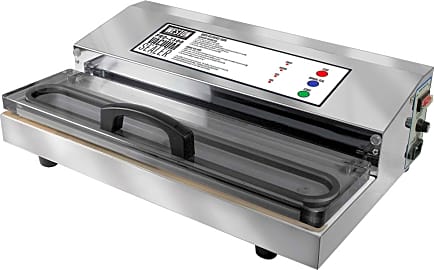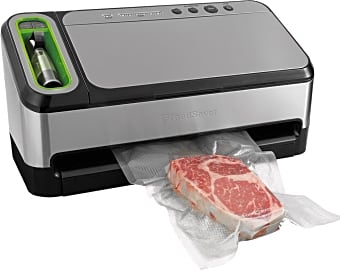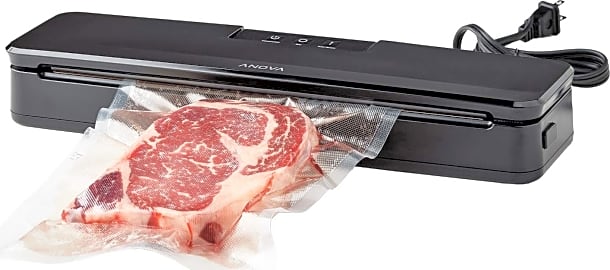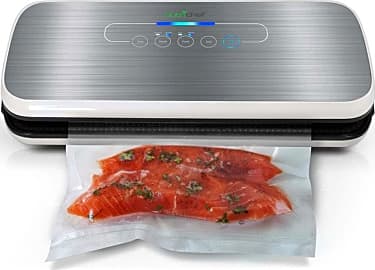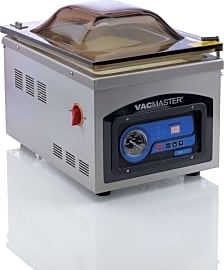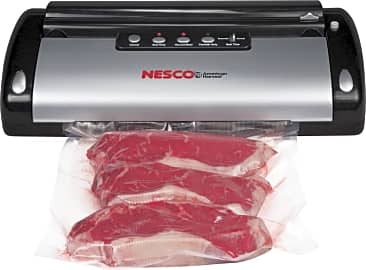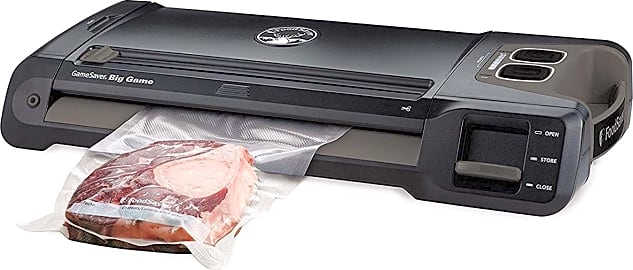The 9 Best Vacuum Sealers

This wiki has been updated 40 times since it was first published in May of 2015. The average family of four throws away about 25 percent of the food it purchases. But you can easily reduce that waste by storing leftovers and raw ingredients properly, and there's no better way to do that than with one of these vacuum sealer machines. By removing oxygen, they preserve freshness and flavor, and they also come in quite handy if you do a lot of sous vide cooking. When users buy our independently chosen editorial picks, we may earn commissions to help fund the Wiki.
Editor's Notes
July 23, 2021:
We've got a great selection of vacuum sealers here and we were not compelled to make any big changes today. We did remove a generic model with subpar long-term reviews and availability. Otherwise, our remaining recommendations should have something for everyone. Home users will love the Nesco VS-12 for its reasonable price and compact design, while busy culinary professionals may well have used the VacMaster VP215 in the past. There are none better than those from VacMaster for preparing an entire day's worth of vacuum-sealed steaks for the sous vide machine.
July 23, 2020:
During this round of updates, while the Homgeek Automatic was removed due to availability issues, we also eliminated the Geryon Starter Kit in favor of an alternate compact model: the Anova Culinary ANVS01-US00. And, we decided on doing away with the FoodSaver FM2435 — recognizing that we’d already included two excellent options from the company on this list, and wanting to make room for the VacMaster VP215 — which features a 1/4-horsepower rotary oil pump that allows it to continue operating indefinitely, without intermittent cool-down time between seals, although it does need to have its oil changed roughly twice a year. Our last addition was the Nesco VS-12 — which can perform 100 consecutive seals without overheating.
A few things to think about for this category:
External vs. Chamber: Most of the models we included in our rankings are external models, and for most users this is the style that we recommend. Two notable exceptions are the VacMaster VP210 and VacMaster VP215, which are chamber vacuum sealers. Most users will find these options prohibitively expensive or excessively bulky, but they are particularly well suited to sealing liquids, so they might appeal to you if that’s a primary goal for your sealer
The VacMaster VP215 in particular can run indefinitely, sealing packages for hours without needing time to cool down, and it performs quite a bit faster than the VacMaster VP210, making it a suitable choice for some industrial applications.
Compatibility: With the majority of vacuum-seal bags on the market available in standardized sizes between eight and 11 inches, we endeavored to ensure that all of our selections were equipped with irons that are at least that wide. The Weston Pro-2300 is one option that goes above and beyond, with a 15-inch iron that allows it to take on extra-large bags.
Bells and Whistles: While some models – like the Koios 4-in-1 and Anova Culinary ANVS01-US00 – include a few bags to help you get started sealing, other options – like the Nesco VS-12 and FoodSaver 4840 – have on-board storage for rolls of sealing bags and power cords. Advanced models – like the FoodSaver 4840 and NutriChef PKVS18 – feature suction hoses that can be used to seal canning jars and reusable bags, and the FoodSaver GM710 comes with a 12-volt DC adapter, which comes in handy for hunters who might like to bring this unit with them on expeditions, hooking it up to their truck, boat or ATV.
May 31, 2019:
The FoodSaver 4840 is a versatile machine with a built-in handheld sealer for nonstandard bags and other containers, and it has a convenient storage compartment for bag rolls. While pricey, the Weston Pro-2300 is a powerful commercial-grade model with a cooling fan to prevent overheating and an extra-wide 15-inch sealing bar. It's a great choice for restaurants, butchers, and home cooks who buy in bulk. The NutriChef PKVS18 is both attractive and functional, with a simple control panel and a bottle stopper for preserving wine. Hunters will appreciate the FoodSaver GM710, which can seal up to 80 packages consecutively and has a built-in handle that makes it easy to carry. The included DC adapter allows you to plug it in to a cigarette lighter, so you can package fish and game in the field or on a boat.
If you need a reliable machine with a lot of power, it's hard to do better than the VacMaster VP210. This chamber-style sealer maintains the same level of pressure both in and outside the bag, so liquids won't get sucked out along with the air. It double seals each bag and lets you customize the settings for different types of food. However, given its expensive price tag, it's likely overkill for most amateur cooks.
Save Money, Save Time, Save Food, With a Vacuum Sealer
Maybe you bury it underground in scattered locations in the forest.
You've probably been putting food away for a long time. Maybe you wrap it in plastic or foil. Maybe you use a plastic container or a Mason jar. Maybe you bury it underground in scattered locations in the forest. Why mix it up now? Why use something as high-tech as a vacuum sealer?
The first, fancy reason is to cook sous vide, literally "under vacuum" in French. To prepare food sous vide, you need to put your protein (meat or fish) in a bag, remove the air, then immerse it in a precisely heated water bath for a long time. We can thank the molecular gastronomy movement for making sous vide preparation mainstream.
A more pedestrian reason for having a vacuum sealer is to keep your food fresher longer. Freezer burnt food tastes nasty. Freezer burn is the result of dehydration, and it occurs when dry air from the freezer comes in contact with your food. The moisture in the food is sucked out, often settling on the top as ice crystals.
It's totally safe to eat that freezer burnt venison if you want; it won't hurt you at all. It's just not as good. Cut off the worst bits and salvage what you can. Maybe make something spicy to hide the taste. And get yourself a vacuum sealer. You don't want to keep ruining your hard won game meats.
Vegetables also lose water, to the dry constantly moving air of the refrigerator. The cell walls of the plants are no longer sturdy, and your celery goes all soft and limp. I'm guessing you don't like to eat it that way, but I don't really know your life. Maybe that's perfect for you. Maybe the crunch of produce haunts your dreams or something. In that case, make it see pain, man. Wilt that shit. I'll look the other way. I will not judge.
Dry foods, like crackers and bread, become stale by absorbing water. The starches are in a foam-like structure, but when they absorb water they become crystallized. This is both how bread gets soggy and how it goes stale. Science is wild, man.
Keeping air out of contact with the surface of your food will prevent freezer burn and will keep it fresh longer. Fortunately, there's one solution for both - a vacuum sealer.
Okay, So How Does a Vacuum Sealer Work?
There are two types of vacuum sealers: edge sealers and chamber sealers. They work in two different ways.
An edge-style vacuum sealer--like seven of the eight in the video, and four of our top five picks--sucks as much of the air directly out of the bag as it can, leaving the food behind. This is why this type of sealer struggles with liquids--note that it can handle them, but they should be frozen first.
You might have a problem with liquids boiling in them, as the pressure is dropped really low inside of them.
Many people say all cut meats (like sliced ham) seal better when they're frozen. If you're going to seal flour or wet cuts of meat in the sealer, a piece of paper towel between the food and the edge of the bag like so keeps the seal from getting broken by particles of grain or wet bits of bloody filth.
A chamber-style vacuum sealer works by changing the air pressure outside the bag, not inside of it. The bag is placed inside a chamber, as the name suggests, with the edge of the bag hanging off of the sealing bar. The lid is lowered, and the air pressure in the chamber around the bag is reduced until it is low enough for the bag to be pressed around the meat.
Chamber vacuums aren't slowed down by liquids; you can seal sauce or water or hard liquor in them. You might have a problem with liquids boiling in them, as the pressure is dropped really low inside of them. They're more powerful, and you don't have to freeze everything. The workspace is smaller.
Really, it isn't so much that one is better than the other. It depends on what works better for you.
So You're Telling Me I'll Never Go Shopping Again?
If you plan on freezing everything you want to eat in one go, and live out of the freezer for the rest of your life, then yes: you'll never have to go shopping again. Congratulations.
But if you think you can vacuum seal a steak and leave it on the counter, then I'm sorry; the answer is no.
But if you think you can vacuum seal a steak and leave it on the counter, then I'm sorry; the answer is no. Don't do that. You're playing with an anaerobic bacterial fire. Maybe you'll get botulism, maybe it'll be clostridium. But just because it's in a neat little package doesn't mean you made it shelf-stable.
It's extremely important to note some of the most pathogenic bacteria really dig warm, low-oxygen environments, so it's vital you refrigerate or freeze any vacuum-packed items--meats, sauces, vegetables, cheeses--that you would normally keep cool.
Your cereal, nuts, ammunition (I am not an ammo specialist, so you should really look into this before you store your ammo in any way) won't make you sick if you eat them after they're stored in a vacuum-sealed bag, provided they're not all moist and delicious when you put them in. I like to eat my bullets dry, don't you?



